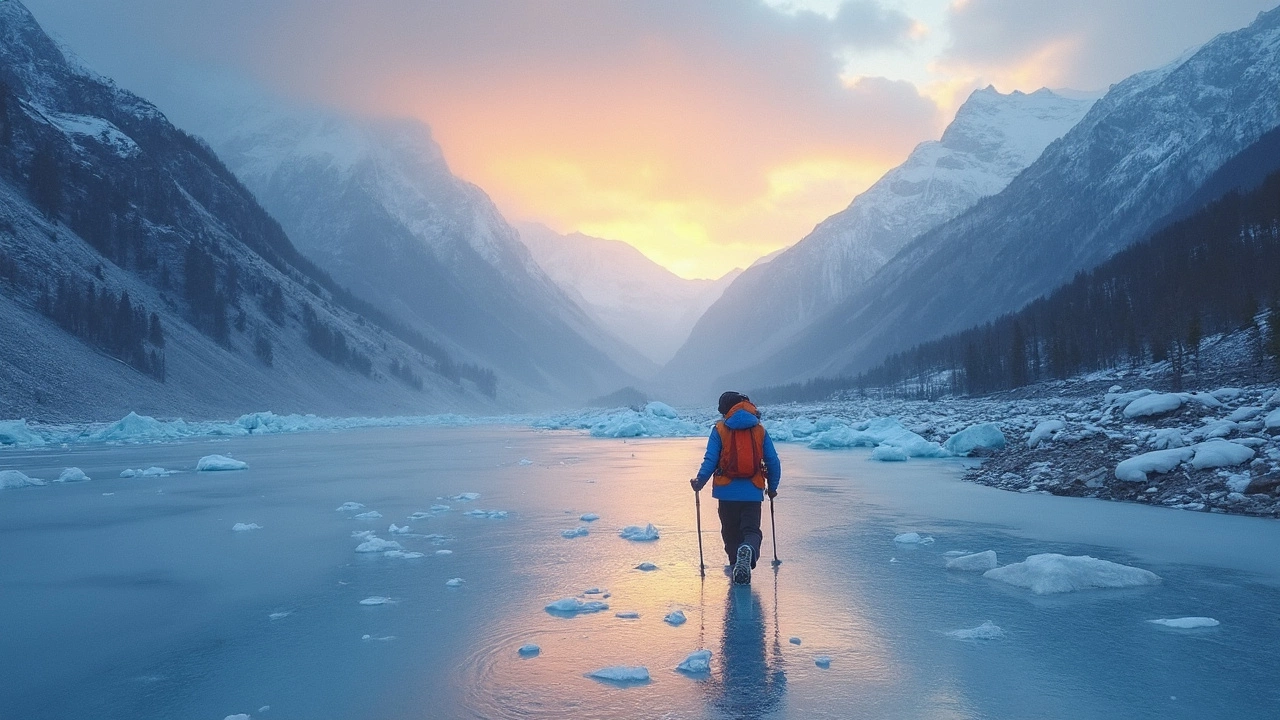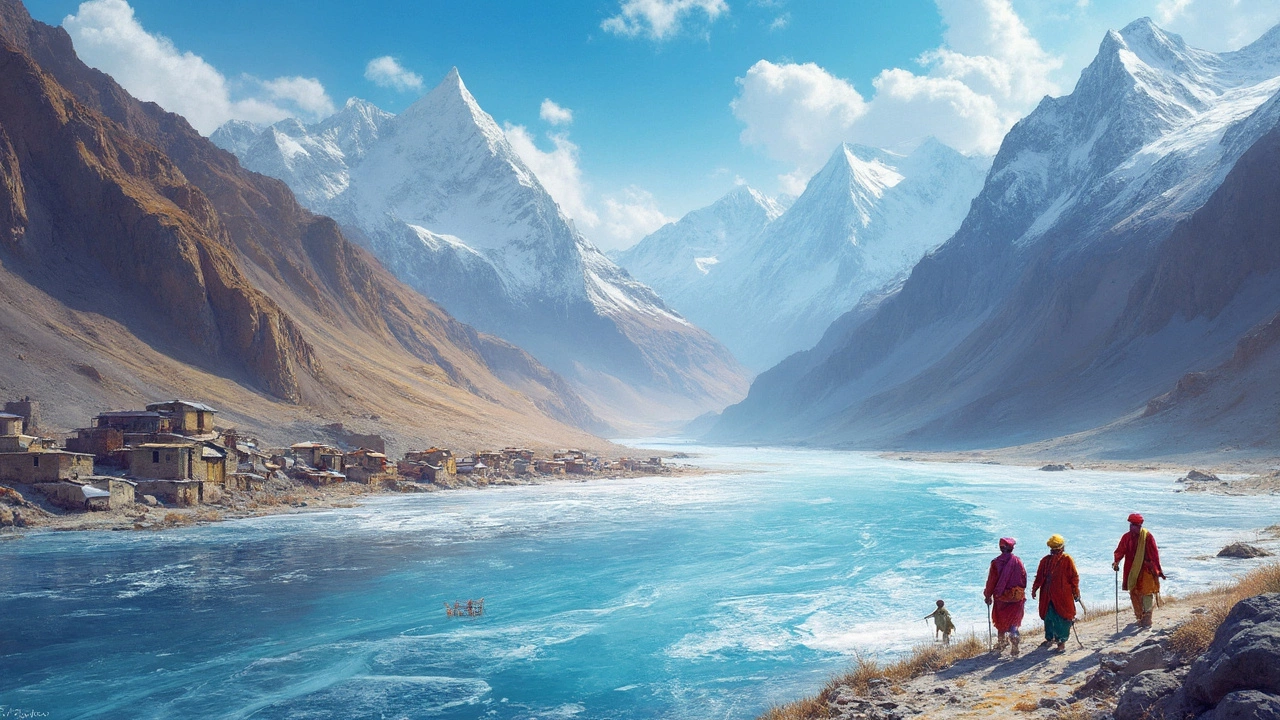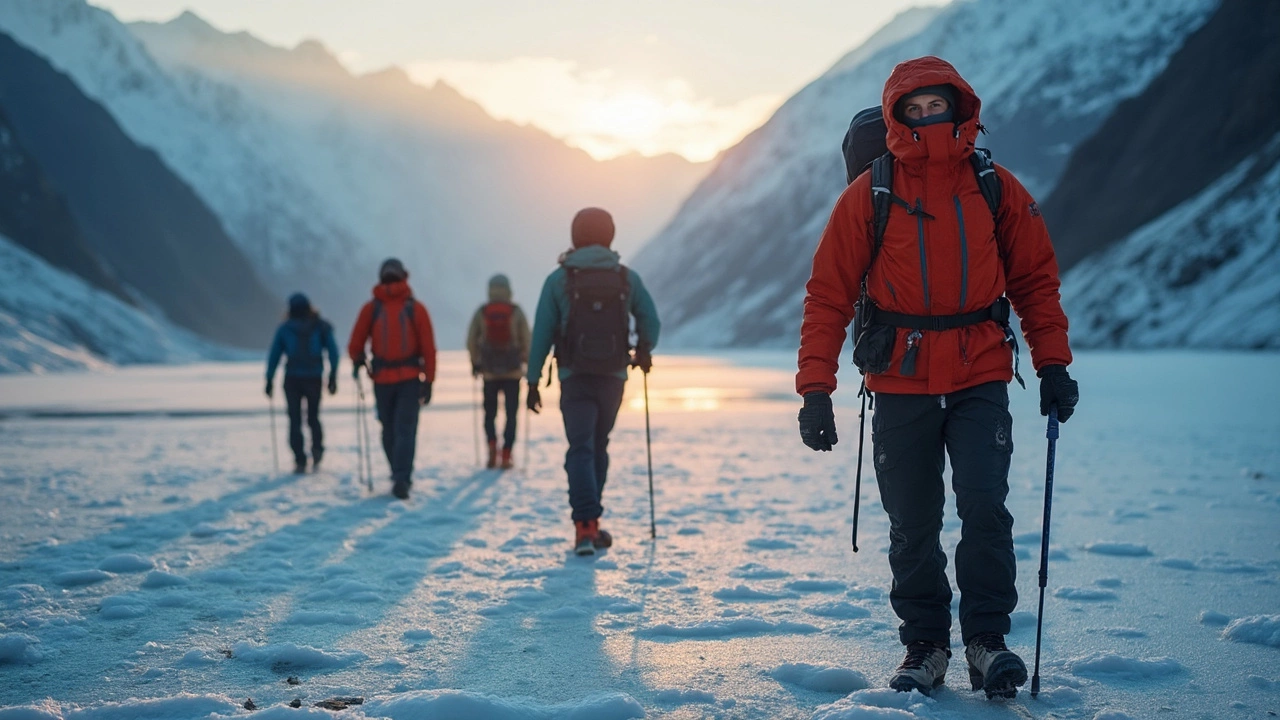Discover India's Toughest Trek: Chadar Trek on Zanskar River
 Feb, 18 2025
Feb, 18 2025
We've all heard stories about the formidable beauty of the Himalayas, but the Chadar Trek on the frozen Zanskar River takes adventure to a whole new level. Imagine walking on ice in freezing temperatures while surrounded by towering mountains. Not for the faint-hearted, this trek is often dubbed the toughest in India for good reason.
Why is it so tough? First off, we're talking about temperatures that can dip as low as -30°C. It's cold enough to make your eyelashes freeze! While that might sound terrifying, it's part of the allure for thrill-seekers. Plus, the trail is literally a sheet of ice, where a slip could mean a dip in freezing water.
Preparation is your best friend for this adventure. Besides the usual trekking gear, you'll need specialized equipment—it’s not like your everyday hike. That means crampons for gripping the ice, layered clothing, and a sleeping bag rated for extreme cold.
- The Chadar Experience
- Challenges of the Trek
- Safety and Preparation
- What to Expect on the Journey
- Tips for First-Time Trekkers
The Chadar Experience
The Chadar Trek is a bucket-list journey for trekkers around the world, offering an adventure that's as thrilling as it is daunting. Imagine navigating a seemingly endless sheet of ice, known as the 'chadar' or blanket, that covers the Zanskar River in Ladakh during winter. This unique landscape is only accessible when the river freezes over, typically from January to February.
Starting from the village of Chilling, trekkers are introduced to a mystical frozen world. The hike spans about 105 kilometers and usually takes 9 days to complete. Each day is a test, but also a chance to immerse yourself in serene beauty. Trekking here feels like walking on another planet. Expect uninterrupted horizons of white, jagged rocks, and the sound of the ice cracking under your weight.
The temperature is relentless. It's not uncommon to face -20°C by day and even colder at night. This means gearing up with the best thermal wears and down jackets is crucial. You also experience the formidable change in the environment as the ice can shift and change, creating new paths or obstacles overnight.
Daily Life on the Trek
Life on the Chadar Trek starts early. Trekkers usually wake up at dawn, and after a quick breakfast, it's time to pack up. Heavy snow boots become your trusty sidekick. The distance you cover each day can vary from 10 to 15 kilometers. It's an endurance test for sure, but that's the essence of the Chadar.
While some may see it as gruelling, the trek offers plenty of moments that make it all worthwhile. Interactions with the local Ladakhi people, who showcase their resilience and adaptability, give invaluable insights. They often join or guide the trekkers, sharing stories of how they've lived alongside this icy river for generations.
Camps and Nighttime Views
Evenings typically involve setting up camp on the river's bank. Trekkers gather around makeshift tents, where warmth comes not just from fires but from camaraderie. For many, gazing up at the star-studded sky with the silhouette of the Himalayas is surreal—a moment to savor.
If you love the idea of challenging your limits amid stunning natural beauty, the Chadar Trek might just be calling your name. Every step on this frozen riverbed is more than just an adventure; it’s a story you’ll relish telling over and over.
Challenges of the Trek
Embarking on the Chadar Trek isn't just about enjoying scenic vistas; it’s about braving some of the harshest conditions that nature can throw at you. Here's why this trek is considered one of the toughest in India.
Extreme Weather Conditions
It's not your standard winter. We're talking about temperatures that regularly plunge to -20°C, and can even hit a bone-chilling -30°C overnight. Your body is constantly working to stay warm, making it both a physical and mental challenge.
Trekking on Ice
Unlike the usual dirt trails, here you're walking on a frozen river. Navigating this icy path requires precision and care. A sturdy pair of crampons is essential for gripping the slick surface, but the ice can still be unpredictable, as it shifts and changes with the weather.
Altitude Challenges
Starting at an altitude of about 11,000 feet, altitude sickness is a real concern. It's crucial to acclimatize properly to avoid headaches or worse. The thin air can make even a small incline feel like a major climb.
| Factor | Details |
|---|---|
| Temperature | -20°C to -30°C |
| Altitude | Approx. 11,000 feet |
| Route Length | 70 miles round trip |
Limited Resources
On the Zanskar River, modern conveniences are scarce. Accommodations are basic, often in tents or local shelters. Being prepared with the right supplies is non-negotiable. That means carrying your own food, fuel, and emergency supplies.
Unpredictable Conditions
The weather on the Chadar can change rapidly. One moment it’s calm, and the next you could be facing a blizzard. It's all about staying alert and being ready to adapt your plans if needed.
This isn’t just a test of endurance; it's about mastering your survival skills in one of the world's most magnificent, yet unforgiving, environments.

Safety and Preparation
Before you even consider the Chadar Trek, you need to get your safety game on point. Remember, this isn't your regular weekend hike; it's trekking in some of the harshest conditions imaginable.
Essential Gear
First up, gear matters—a lot. You’ll need sturdy boots that can handle walking on ice all day long. Crampons are a must-have for grip, along with high-quality thermal wear. Dressing in layers is key. Thermal inners, fleece jackets, and an insulated outer jacket are non-negotiables. Don’t forget good gloves and a woolen cap to protect extremities from frostbite.
Acclimatization
The trek starts in Leh, which is about 3,500 meters above sea level. Spend a couple of days here to let your body get used to the altitude. Acute Mountain Sickness (AMS) can be a real problem if you rush this step. Hydration is crucial, so make sure you're drinking water continuously, even if you don’t feel thirsty.
Guidance and Support
Never attempt the Zanskar River trek without an experienced guide. Local guides know the terrain and can steer you clear of dangerous zones. They’re also equipped to handle emergencies, which is reassuring when you're miles away from civilization.
Emergency Plans
Have a safety plan in place. Satellite phones are recommended as cellular service is mostly unavailable. Keep basic first-aid kits and learn how to handle emergencies, like hypothermia or altitude sickness.
Food and Nutrition
Pack lightweight, high-energy snacks like nuts, chocolate, and protein bars. The harsh environment demands a lot from your body, so you'll need those calories. Keep in mind, cooking or boiling water can be a considerable task here, so pre-packaged meals that can be quickly heated are a good idea.
What's more thrilling than embarking on the toughest trek in India? Doing it safely! Heed these tips, prepare thoroughly, and you'll have stories to tell for a lifetime.
What to Expect on the Journey
Setting out on the Chadar Trek means you're in for a mix of awe-inspiring sights and tough conditions. The journey typically spans about nine days, depending on your pace and the weather. Each day presents new challenges and stunning vistas, so be ready for the unexpected!
Daily Routine and Exploration
Each day on the trek usually begins early, with a hearty breakfast to fuel you for the hours of trekking ahead. You'll be walking roughly 10 to 12 kilometers on ice every day. It's crucial to stay hydrated, even in the cold, so make sure to keep your water bottle handy!
Scenic Beauty and Unpredictable Weather
The views are nothing short of breathtaking. As you make your way across the Zanskar River, towering cliffs of ice and snow surround you. The night sky? It's unlike anything you'll see in the city—brimming with stars.
But watch out for the weather! It can change in the blink of an eye. One moment it’s calm, the next, a snowstorm. Knowledge about the climate is essential, as is listening to your guide's advice.
Local Culture and Living Conditions
A unique aspect of the trek is engaging with the local communities. The Zanskari people are friendly and resilient, living in these harsh conditions year-round. It's a learning experience to see how they adapt and thrive here!
Sleeping arrangements typically consist of tents, which means that all your warmth comes down to your sleeping bag. Make sure it’s up to the challenge of low temperatures!
Special Tips for Trekkers
- Always trek in groups; it's safer and more enjoyable.
- Pack extra batteries for your cameras; cold drains power fast.
- Practice some basic photography; you'll want to capture these moments!
Remember, while the Chadar Trek offers incredible sights and adventures, it’s also about pushing your limits and discovering a new part of India few have set foot in.

Tips for First-Time Trekkers
Taking on the Chadar Trek can be daunting, especially for newcomers to high-altitude trekking. Don’t worry, though—I've got some practical tips that will help you make the most of this unforgettable journey.
Get Physically Ready
This isn't your average stroll in the park. Start getting in shape several months before you go. Focus on cardio exercises, strength training, and leg workouts. Building endurance is key when you're trekking through snow and ice for hours each day.
Gear Up Properly
Your equipment is your lifeline on this trek. You’ll need crampons for traction on the ice, a backpack that can handle the elements, and thermal clothing to ward off those sub-zero temperatures. Don’t forget high-quality trekking boots!
Acclimatization Matters
The altitude can be brutal if you're not prepared. Spend a couple of days at Leh before you start to acclimatize. It’s a crucial step to prevent altitude sickness and enjoy the toughest trek in India without any health hitches.
Water and Nutrition
- Stay hydrated. It’s easy to underestimate how much fluid you lose in cold weather.
- Carry high-energy snacks. Think nuts, chocolate, and granola bars to keep your energy up.
Respect the Environment
Remember, you're a guest in this stunning landscape. Stick to the paths, pack out all your trash, and be mindful of local customs. The Zanskar River and surrounding areas are not just a trekker's paradise but a vital habitat and home to locals who will welcome you warmly.
By taking these tips to heart, you're not only ensuring your safety but also enhancing the overall experience of conquering this incredible challenge.